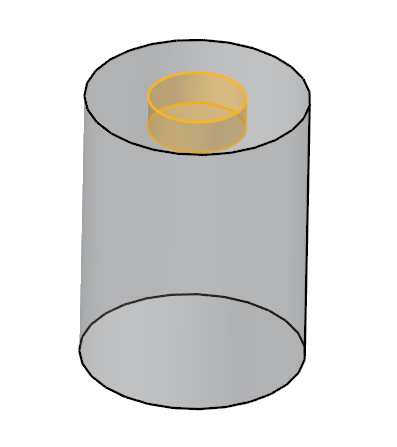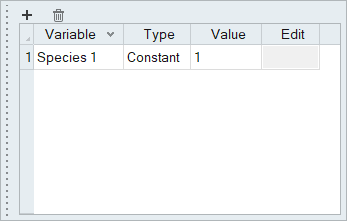ACU-T: 4300 Species Transport Modeling
Tutorial Level: Advanced
This tutorial provides instructions for modeling species transport using HyperMesh CFD. Prior to starting this tutorial, you should have already run through the introductory tutorial, ACU-T: 1000 Basic Flow Set Up, and have a basic understanding of HyperMesh CFD and AcuSolve. To run this simulation, you will need access to a licensed version of HyperMesh CFD and AcuSolve.
Problem Description
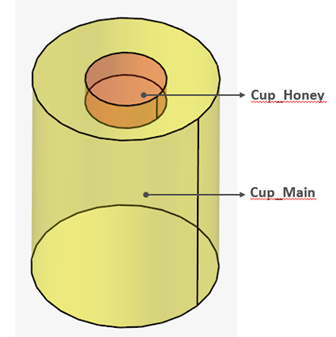
Start HyperMesh CFD and Open the HyperMesh Database
- Start HyperMesh CFD from the Windows Start menu by clicking .
-
From the Home tools, Files tool group, click the Open Model tool.
Figure 2. 
The Open File dialog opens. - Browse to the directory where you saved the model file. Select the HyperMesh file ACU-T4300_HoneyTeaSpecies.hm and click Open.
- Click .
-
Create a new directory named HoneyTeaPlug and navigate into this directory.
This will be the working directory and all the files related to the simulation will be stored in this location.
- Enter HoneyTeaPlug as the file name for the database, or choose any name of your preference.
- Click Save to create the database.
Validate the Geometry
-
From the Geometry ribbon, click the Validate tool.
Figure 3. 
The Validate tool scans through the entire model, performs checks on the surfaces and solids, and flags any defects in the geometry, such as free edges, closed shells, intersections, duplicates, and slivers.The current model does not have any of the issues mentioned above. Alternatively, if any issues are found, they are indicated by the number in the brackets adjacent to the tool name.
Observe that a blue check mark appears on the top-left corner of the Validate icon. This indicates that the tool found no issues with the geometry model.Figure 4. 
- Press Esc or right-click in the modeling window and swipe the cursor over the green check mark from right to left.
- Save the database.
Set Up Flow
Set the General Simulation Parameters
-
From the Flow ribbon, click the Physics tool.
Figure 5. 
The Setup dialog opens. -
Under the Physics models setting:
- Set Time marching to Transient.
- Set the Time step size to 0.125 sec.
- Select Laminar as the Turbulence model.
- Check the Include Gravitational Acceleration option and set the gravity to 9.81 m/s2 in the z direction.
- Set the Number of passive species to 1.
Figure 6. 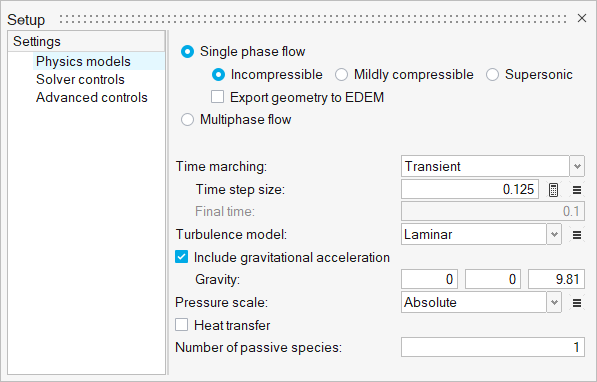
-
Click the Solver controls setting then set the Transient
maximum steps to 80.
Figure 7. 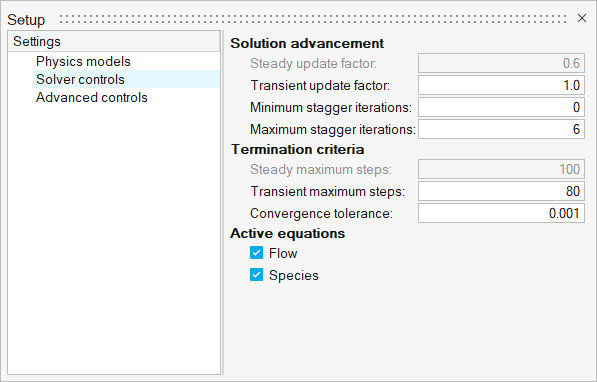
- Close the dialog and save the model.
Assign Material Properties
-
From the Flow ribbon, click the Material Library tool.
Figure 8. 
The Material Library dialog opens. - Under Settings, click Fluid, and then click the My Materials tab.
-
Click
 to create a new material.
to create a new material.
-
For density:
- Change the type to Piecewise Linear.
- Define the Curve fit variable as Species 1.
-
Click
 twice under Function then enter
1000 kg/m3 and
1500 kg/m3 in the Y column for the
density of water and honey, respectively.
twice under Function then enter
1000 kg/m3 and
1500 kg/m3 in the Y column for the
density of water and honey, respectively.
Figure 9. 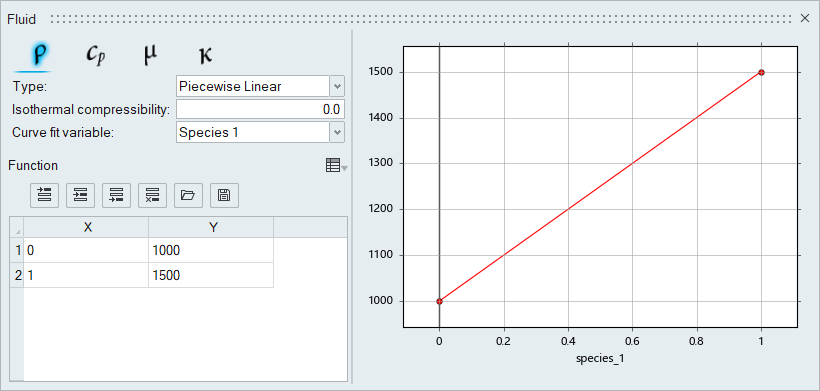
-
Similarly, define the viscosity (kg/m-sec) values for water and honey according
to the figure below.
Figure 10. 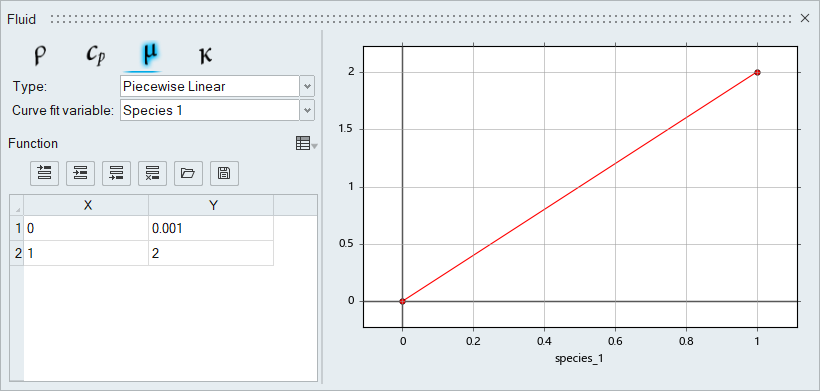
-
Close the material editing dialog, then rename the Fluid material to
Honey.
Figure 11. 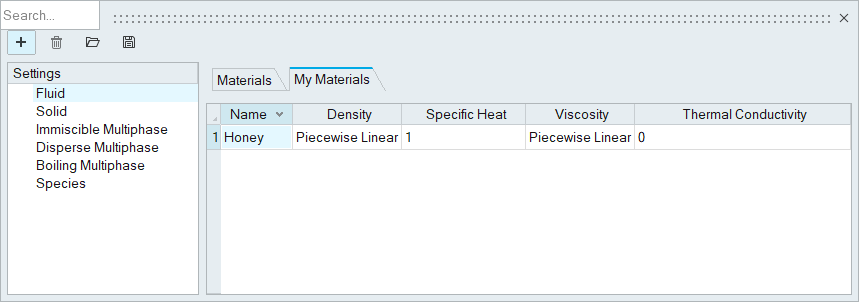
-
From the Flow ribbon, click the Material tool.
Figure 12. 
- Select both model volumes.
-
Select Honey from the Material drop-down menu.
Figure 13. 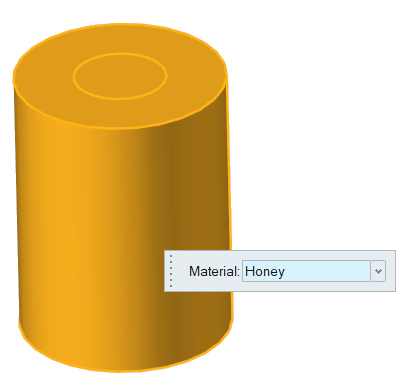
-
On the guide bar, click
 to execute
the command and exit the tool.
to execute
the command and exit the tool.
Define Flow Boundary Conditions
-
From the Flow ribbon, click the Slip tool.
Figure 14. 
-
Select the top two surfaces highlighted in the figure below and then click
 on the guide bar.
on the guide bar.
Figure 15. 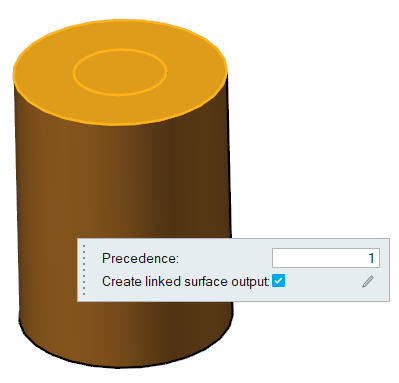
Define Nodal Outputs and Nodal Initial Conditions
-
Define nodal output frequency.
-
Define the nodal initial conditions.
- Save the model.
Run AcuSolve
-
From the Solution ribbon, click the Run tool.
Figure 21. 
The Launch AcuSolve dialog opens. - Set the Parallel processing option to Intel MPI.
- Optional: Set the number of processors to 4 or 8 based on availability.
- Uncheck the Automatically define pressure reference option.
- Expand Default initial conditions and uncheck the Pre-compute flow and Pre-compute turbulence options.
- Set all the velocity components to 0 m/s.
-
Leave the remaining options as default and click
Run to launch AcuSolve.
Figure 22. 
Post-Process the Results with HM-CFD Post
- Once the solution is completed, navigate to the Post ribbon.
- From the menu bar, click .
-
Select the AcuSolve
.log file in your problem
directory to load the results for post-processing.
The solid and all the surfaces are loaded in the Post Browser.
Figure 23. 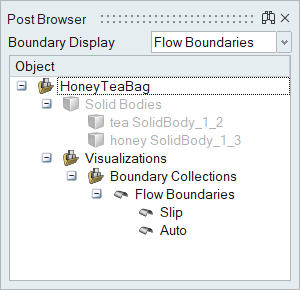
-
From the Post ribbon, click the Slice Planes tool.
Figure 24. 
-
Select the plane shown in the figure below.
Figure 25. 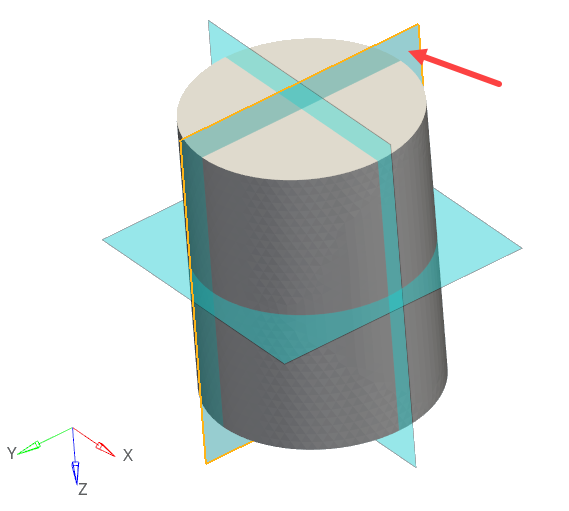
- In the Post Browser, hide the Slip and Auto surfaces.
-
In the slice plane microdialog, click
 to
create the slice plane.
to
create the slice plane.
- In the display properties microdialog, change the Display option to species 1.
-
Activate the Legend radio button and then click
 and set the Colormap name to
Rainbow Uniform.
and set the Colormap name to
Rainbow Uniform.
Figure 26. 
-
Click
 on the guide bar.
on the guide bar.
-
Make sure that the time scale at bottom of the modeling window is at 1 sec.
Figure 27. 
-
Adjust the time scale to show 2 sec, 4, sec, 6 sec, 8 sec, and 10 sec.
The distribution of species 1 (honey) at those times is shown below.
Figure 28. 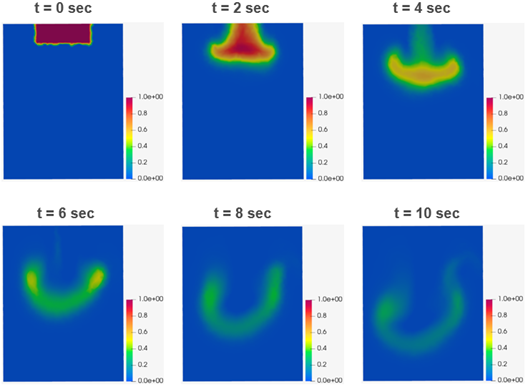
- In the Post Browser, hide the slice plane and show the Auto and Slip surfaces.
-
Click the Boundary Groups tool.
Figure 29. 
- Select all the surfaces on the model to create a new boundary group.
-
In the microdialog, move the Transparency slider to the
middle to add a transparency effect.
Figure 30. 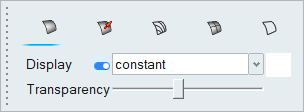
-
Click
 on the guide bar.
on the guide bar.
-
Click the Iso-Surfaces tool.
Figure 31. 
-
In the Iso-function microdialog, change the Iso
Variable to species 1 and set the Iso Value to
0.5
Figure 32. 
-
Click Calculate and then click
 .
.
Figure 33. Distribution of species at 3 sec 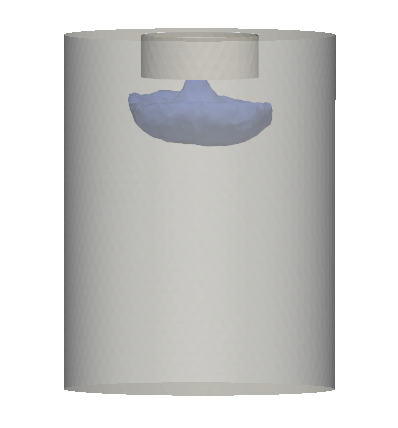
Summary
In this tutorial, you successfully learned how to set up and solve a simulation involving species transport using HyperMesh CFD. You started by opening the HyperMesh input file with the geometry and then defined the simulation parameters, fluid material, and boundary conditions. Once the solution was computed, you visualized the results of species transport with help of planes and an iso-surface.



